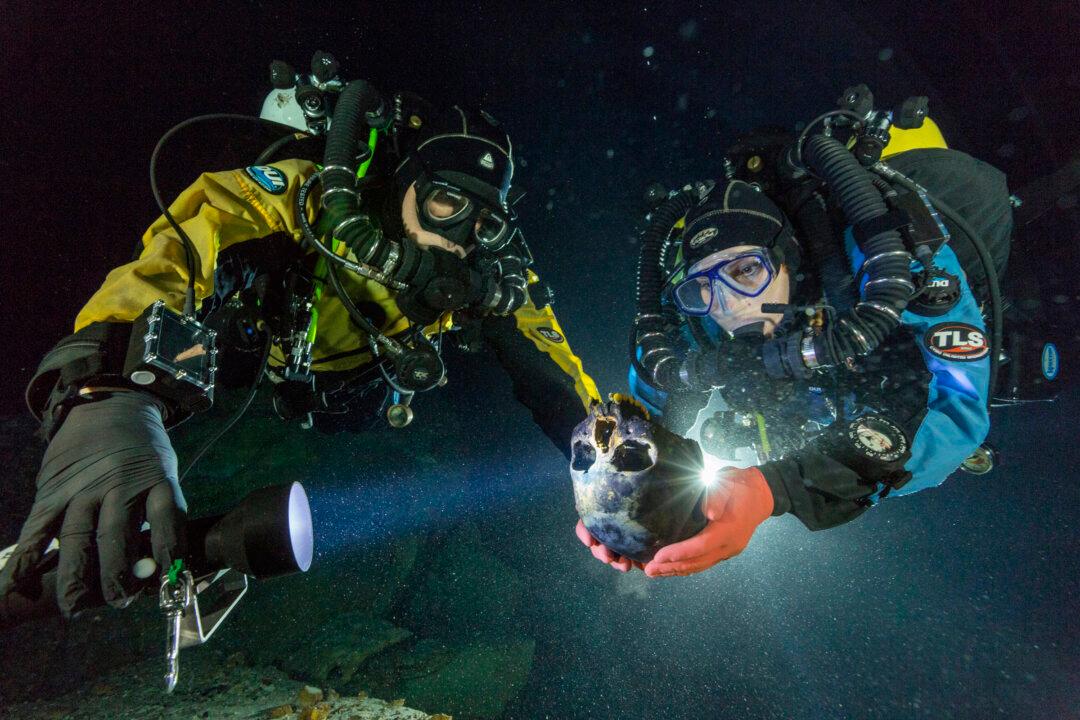The discovery of a nearly complete fossil skeleton of a teenage girl in the Hoyo Negro submerged cave system in Mexico’s Yucatan Peninsula provides new insight into the first people to inhabit the Americas at the end of the last ice age.
Our knowledge of the appearance of the earliest Americans, called Paleoindians by anthropologists, their background and inherited traits is based on no more than 30 individual skeletons found in the entire North American continent. Most of these include only fragments of the entire skeleton, and only twelve have been directly dated. So the addition of any newly discovered Paleoindian skeleton constitutes a major find – the fact that this skeleton is nearly intact makes it very rare.
Unfortunately, the preservation of collagen was extremely poor in these waterlogged bones, so indirect dating techniques had to be used. The authors, led by Jim Chatters, argue the skeleton’s age must be constrained by the timing of the sink hole’s inundation as sea levels rose. Using the uranium-thorium radiometric dating method on the calcite florets – mineral deposits – that accumulated on the exposed bones of the skeleton before the chamber filled with sea water, the skeleton is placed at a minimum age of around 12,000 years (+/- 200 years).
Radiocarbon ages on the skull’s tooth enamel suggest a calibrated age of 12,900-12,700 years, making her one of the oldest human finds in the Americas. So it appears that this teenage girl, which the dive team named Naia, fell into the sinkhole and died sometime between 12,000 and 13,000 years ago, just at the end of the last glacial period.
Genetic History of America
What is interesting about Naia’s body, small at only 4ft 10ins and surrounded by the bones of sabre-tooth tigers, pumas, and other animals that shared her fate in the sinkhole over the centuries, is the ancient mitochondrial DNA extracted from a molar tooth. Mitochondrial DNA is genetic material that is inherited solely from the mother, and so can be used to trace hereditary genetic relationships. After genetic sequencing, the authors placed her DNA within the D1 subgroup of “haplogroup D”. A haplogroup is a section or group of sections of mitochondrial DNA collectively inherited from the mother.
The D haplogroup is thought to have originated in Asia some 48,000 years ago, and is one of five found among Native American peoples, the others being A, B, C, and X. But this particular subgroup D1 occurs only in the Americas, and the discovery of this skeleton adds weight to what is known as the Beringia Standstill hypothesis. This holds that the original ancestral Native Americans were isolated genetically from other populations for thousands of years.
The proponents of the hypothesis, Erika Tamm and colleagues, estimate that Asian and American mitichondrial DNA haplogroups diverged more than 25,000 years ago, but that the latter dispersed in the New World less than 15,000 years ago. The age of the skeleton from Hoyo Negro falls well within this chronology.
Putting a Face to a Name
Another intriguing aspect of Naia’s skeleton concerns her facial features and teeth. She like other Paleoindians, and unlike most contemporary Native Americans, had smaller, narrower skulls and sharply projected faces. This also supports the idea that all Paleoindians derive from the same source populations in Asia, via Beringia.
The late and noted anthropologist Christy Turner said of this theory in 1999 that the facial features and teeth of Paleoindian skulls he’d examined led him to believe that these people had an appearance unlike either their Asian ancestors, or their Native American descendants. In Turner’s view, these people “looked more like each other than they did anybody else”.
This unusual facial appearance, unlike contemporary Native Americans or northeast Asians, has perplexed paleoanthropologists for decades, leading some people to suggest that the Paleoindians were perhaps descended from a European ancestor, or possibly the ancestors of the modern Ainu people of Japan. This is because some of the facial features seen on Paleoindian skulls are more similar to Caucasian features. These aspects of Paleoindian facial features were clearly preserved in Kennewick Man, a 7,000-year-old Paleoindian skeleton from Washington state discovered by Jim Chatters in 1996.
Instead, the differences between the cranio-facial features of modern Native Americans and Paleoindians are due to evolutionary changes that have come since the divergence of Beringians from their Asian ancestors, brought to America in subsequent waves of immigration.
Naia’s remains are key to explaining the Paleoindians’ unique facial appearance, and how they can be, despite their differences, both descendants of ancient Asian peoples, and the ancestors of most Native North American groups of today.
Scott Armstrong Elias receives funding from the US National Science Foundation to conduct research on the Bering Land Bridge. This article was originally published on The Conversation. Read the original article.
